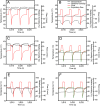Development of a New Method for Evaluating Heat and Moisture Exchanger Performance
- PMID: 38981654
- PMCID: PMC11469012
- DOI: 10.4187/respcare.11696
Development of a New Method for Evaluating Heat and Moisture Exchanger Performance
Abstract
Background: A model system described in International Organization for Standardization 9360 is the standard method for estimating the humidifying performance of heat and moisture exchangers (HMEs). However, there are no reliable bedside methods for evaluating the ongoing humidification performance of HMEs. Therefore, this study aimed to develop 2 clinically applicable methods for estimating the ongoing humidifying performance of HMEs and to evaluate their reliability in a model system.
Methods: Physiologically expired gas was simulated using a heated humidifier, and ventilation was delivered using a ventilator with constant flow through 3 different types of HMEs. Relative humidity (RH) was measured using a capacitive-type moisture sensor. Water content lost during expiration was calculated by integrating absolute humidity (AH), instantaneous gas flow measured at the expiratory outlet of the ventilator, and time. We also calculated the water content released and captured by the HMEs during tidal ventilation by integrating the difference in AH across the HMEs, instantaneous gas flow, and time.
Results: We found that the RH, temperature, and AH were almost constant on the expiratory outlet of the ventilator but rapidly varied near the HMEs. The water content lost by the 3 HMEs was associated with the manufacturer-reported values and inversely correlated with the calculated values of the water content exchanged by the HMEs. The water content released and captured by HMEs was closely correlated with the difference in HME weight measured at the end of inspiration and expiration; however, the water content captured by HMEs seemed to be overestimated.
Conclusions: Our results demonstrated that our system was able to detect the differences in the performance of 3 models of HMEs and suggest that our method for calculating water loss is reliable for estimating the water retention performance of HMEs during mechanical ventilation, even in the presence of a constant flow.
Keywords: Heat and moisture exchanger; humidification; humidity; mechanical ventilation; water content; water exchange; water retention.
Copyright © 2024 by Daedalus Enterprises.
Conflict of interest statement
The authors have disclosed no conflicts of interest.
Figures




Comment in
-
Reply to the Comment from Dr. Lellouche, Entitled "New Methods for Evaluating Passive Humidifiers Highlight Problems With Current ISO Standards".Respir Care. 2025 Mar;70(3):362. doi: 10.1089/respcare.12757. Epub 2025 Feb 6. Respir Care. 2025. PMID: 39969917 No abstract available.
-
New Methods for Evaluating Passive Humidifiers Highlight Problems With Current ISO Standards.Respir Care. 2025 Mar;70(3):359-361. doi: 10.1089/respcare.12623. Epub 2025 Feb 3. Respir Care. 2025. PMID: 39969941 No abstract available.
References
-
- Vargas M, Chiumello D, Sutherasan Y, Ball L, Esquinas AM, Pelosi P, et al. Heat and moisture exchangers (HMEs) and heated humidifiers (HHs) in adult critically ill patients: a systematic review, meta-analysis, and meta-regression of randomized controlled trials. Crit Care 2017;21(1):123. - PMC - PubMed
-
- Restrepo RD, Walsh BK; American Association for Respiratory Care. Humidification during invasive and noninvasive mechanical ventilation: 2012. Respir Care 2012;57(5):782-788. - PubMed
-
- Djedaini K, Billiard M, Mier L, Le Bourdelles G, Brun P, Markowicz P, et al. Changing heat and moisture exchangers every 48 hours rather than 24 hours does not affect their efficacy and the incidence of nosocomial pneumonia. Am J Respir Crit Care Med 1995;152(5 Pt 1):1562-1569. - PubMed
-
- Lellouche F, Taille S, Lefrancois F, Deye N, Maggiore SM, Jouvet P, et al. ; Groupe de travail sur les Respirateurs de l’AP-HP. Humidification performance of 48 passive airway humidifiers: comparison with manufacturer data. Chest 2009;135(2):276-286. - PubMed
Publication types
MeSH terms
Substances
LinkOut - more resources
Full Text Sources

